Toilet tiles: types and design ideas

In most cases, tiles are chosen as the material for finishing the toilet room. In hardware stores, the range of this coating is presented in many varieties, so it can be difficult for many to choose the most suitable option for a particular restroom. In addition, not everyone knows exactly what types of tiles exist, how much the choice should depend on the style of decoration of the room, as well as what interesting compositions can be created in the toilet using a tiled covering. All these and other nuances will be discussed in detail in this article.




Advantages and disadvantages
Before considering specific options for tiles in the toilet, you should pay attention to the positive and negative qualities of this material. The pluses of the coating include the following characteristics:
- the tiles are easy to keep clean, this requires minimal maintenance - wet cleaning as the surface becomes dirty;
- the material does not absorb foreign odors, such as detergents;
- the service life of such a coating is quite long - up to 10 years;
- tile parts are resistant to fire and even prevent its spread to some extent;
- it is important that the tiles are hypoallergenic;
- tile products can withstand a fairly large load due to their high level of strength.


However, do not forget that the coating of tiled material also has its own negative nuances:
- some do not like the tactile sensations of such a finish - it is regarded as rather cold to the touch;
- tiles do not contribute to soundproofing the room;
- to make a truly exclusive design of a bathroom using this coating, you will have to spend a rather large amount;
- despite its strength, the tiles are characterized by fragility - the material can crack if a heavy object is dropped on it or if the tile itself is dropped from your hands;
- It will be difficult for inexperienced users to tile the surfaces on their own, so there will be additional costs for the services of a tiling tiler.

Varieties
There are several criteria by which toilet tiles are classified into different types. The first sign is the surface on which the material is located. Allocate tiles for walls, floors and ceilings.
If the washroom also has a sink with a cabinet, then the surface of the cabinet can also be decorated with tiles.


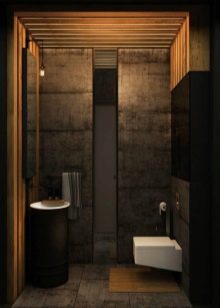
Mosaic
A separate type is floor and wall tiles such as mosaics. It represents small products with dimensions 1x1, 2x2 or 5x5 cm. Moreover, the shape of such mini-parts can be square, diamond-shaped, polygonal, asymmetrical, round and even irregular.

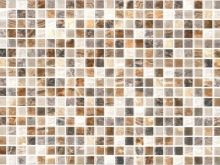

The process of laying such a tile is usually very laborious, especially if it contains a pattern.
In turn, it is presented in stores not only in the form of piece items, but also in the form of block products. Block variants are larger wall fragments, the size of which is about 30x30 cm. All small fragments are already located on such canvases, so you do not have to lay them out manually.

Mosaic materials can be varied. Among them, there are such as glass, which includes metal oxides, as well as quartz sand and feldspar. Brass and steel used to create metallic mosaic variations. The metal tile cladding is carried out using a special rubber base.
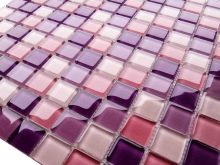


The smalt type mosaic is created using dye, as well as pressed glass and is great for heavy loads. The most expensive option is stone mosaic, the raw material for which is the marble component, malachite, granite, jasper, as well as slate, onyx and malachite.



Porcelain stoneware
Porcelain stoneware tile materials are most often used as floor coverings. The composition of such cladding includes feldspar, clay, quartz sand, and dyes. The material is rough to the touch, but such tiles are not characterized by strong sliding and are considered safer.



Other positive properties of such a cladding are that the material does not tarnish over time, is resistant to the formation of bacteria and fungi, and also has a low level of electrical conductivity.
However, among the negative aspects of porcelain stoneware, it is noted that he is cold to the touch... The cost of coverage is also quite expensive. In addition, in the process of transporting and cutting the material, it can exhibit increased fragility.
Tile
A separate variety is the "hog" tile, which has the shape of a rectangle, as well as a chamfer. Tile pieces have 45 degree beveled edges and a convex shape. In terms of size, such products are of two types - 7x10 cm, as well as 25x30 cm. The hog tile is characterized by a high level of strength, resistance to temperature extremes and wear, and ease of maintenance. The texture can be matte, glossy, glassy or imitating other materials.



Traditional ceramic options are used mainly for walls. Ceramic tiles have not only traditional shapes, but also more complex, polygonal shapes that resemble a honeycomb.




Drawings and colors
The tiles in the restroom are not always monochromatic. Finishes can often be seen in various patterns and color combinations. Some of the most popular pattern options are:
- horizontal or vertical stripes;
- Checkerboard pattern;
- gradient transition from several tones;
- ethnic ornaments, abstractions (they are often used to distinguish individual sections of the toilet, and not the entire wall).
- a light background in combination with shiny elements located chaotically;
- silhouettes of various objects, animals, plants.
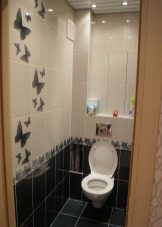



It is also worth highlighting products of textured type. They are made in such a way that the tiles imitate other materials such as brickwork, wood, metal, natural stone and even fabric.
Absolutely unique products of this type can be created using photo printing. The disadvantages of this design are the difficulty in caring for the material, as well as the high cost of decorating a bathroom in this way.


Since the bathroom is usually small in area, they try to visually expand it with the help of tiling. And the correct selection of coating colors greatly helps in this.
- For the ceiling, in most cases, a white tone is used, while for walls, other shades can also be used, in most cases neutral or pastel.
- The back wall, which is located behind the toilet installation, is often accentuated. It can be tiled with dark tiles, such as brown or gray, while the side walls remain lighter, but consistent with the accent color scheme. Ornamental tiles may also be present on the back wall.
- Sometimes there is a contrast on the walls in the form of rectangular tiles arranged horizontally in a row at the level of the middle of the wall. They tend to have a brighter tone than the main square-shaped coating.
- If you plan to combine 2 or 3 colors in the design of the bathroom, remember that one of them should dominate 60% of the total. It is not recommended to use more than 3 shades.
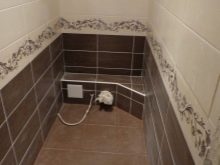


If we consider the tiled covering for the restroom in terms of color combinations, then it is worth highlighting the following color ensembles that will look the most successful:
- deep pink with lavender;
- pale emerald with brick color;
- gray with blue;
- milky shade of white with black;
- wine red with vanilla;
- blue with gold;
- beige with ocher;
- brown with yellow;
- light green with turquoise;
- fuchsia with lilac;
- olive with light gray.




Popular brands
Among the manufacturers of tiles for interior decoration, various companies are distinguished, which are usually classified into groups based on the cost and class of products.
- Among the manufacturers of inexpensive coating, it is worth noting the company Kerama Marazzi, Cersanit, and Keramin. Both domestic and German manufacturers are popular.


- The main countries producing tiles for the middle price segment with a high price-quality ratio are countries such as Italy, France, Spain, as well as a Russian-Italian joint production. Examples include the brands Italion, Fap Ceramiche, Lafabbrica.

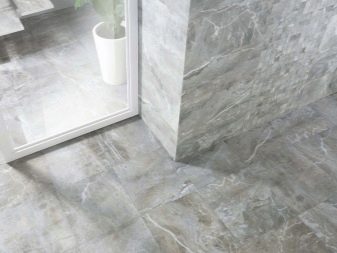
- Among the premium products, there are tiles made by companies Grazia Venice, Laminam Kanka, Vallegunga Foussana.

How to choose?
It is important, even in the selection process, to take into account a number of signs, which will help you choose the perfect tile for your toilet.
- Pay attention to product labeling. Red denotes products of the highest quality, blue is used for coatings of average quality, and the most budgetary options are denoted in green.
- In addition, chemical resistance is also labeled. AA stands for high level of resistance, B for medium, and C for low level.
- The wear resistance level of the material is indicated by Roman numerals. It makes sense to choose products (especially for floors), the stability of which is in the range from 1 to 3.
- It is better to calculate in advance the area to be covered, and this applies not only to the material, but also to the glue. This will make it much easier to determine the number of tiles when buying.

Laying methods
To beautifully decorate the walls, floor or ceiling in the washroom, you should remember about certain options for laying tile material.
- The most common is standard way, similar to the principle of laying bricks. The edge of each new product is shifted by half the length of the elements from the previously laid row.
- Stacking applies both horizontally and vertically, according to whether horizontal or vertical tiles are used. The main nuance of such cladding is the arrangement of the seam elements in the seam, with special attention paid to the evenness of the seams.
- Vertical offset similar to standard masonry, however, the tiles are shifted to the middle of the previous row along the vertical edge.
- "Chess" assumes 2 options for the location of the coating: the alternation of vertical and horizontal rectangular parts arranged in 2 pieces, or the color alternation of square elements of different tones. In this way, the tiles can be placed both on the wall and on the floor.
- For spacious washrooms, you can use diagonal option for placing tiles.
- "Herringbone" fits not only in the parquet finishing of the apartment, but also in the form of tiles in the bathroom. However, stacking in this way requires a complex 45-degree cut.
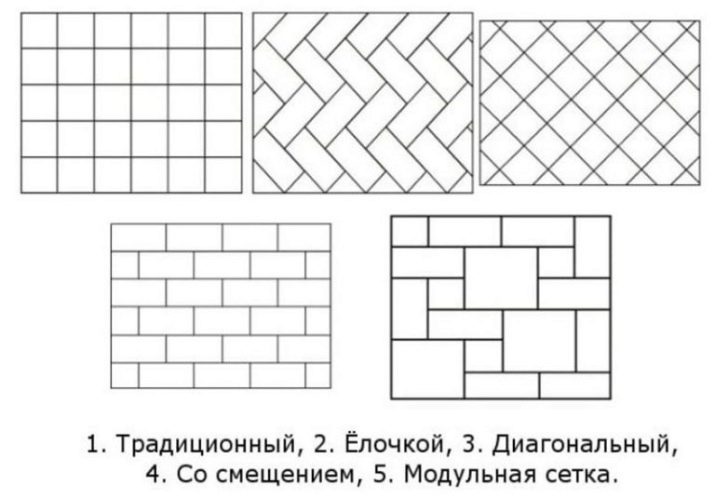
Use in different styles
The decoration of any room in the apartment, including the bathroom, is unacceptable without taking into account the style of the interior in which the room will be decorated. The design of the restroom can be made in the following styles, each of which has its own nuances of finishing decor.
- Loft style created using tiles that imitate brickwork. Moreover, communications, such as pipes, are not blocked by anything. The tiles can be made in either white or red. Sometimes dark walls made of wood-like panels are combined with accent brick-like tiles.
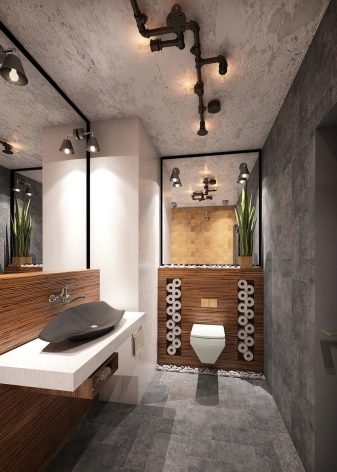

- For luxury style Art Deco decoration with tiles in light colors, which has a non-standard shape, for example, hexagonal, is suitable. Floor tiles are chosen mainly in dark shades.


- Direction high tech allows the use of glass tile elements with a mirror finish, as well as cladding decorated with a metal look.

- Beige, white, light yellow and gray colors, as well as simple shapes are a great idea. for a modern style.



- V eco-style the toilet can be finished with terracotta colored porcelain stoneware flooring.
For walls, it is better to choose a textured finish made under a tree.

Successful examples
If you find it difficult to choose a tile for your bathroom, check out specific examples, in which the tiled flooring looks very harmonious and original.
- The soft green shade matches the ivory color perfectly, even if the shape of the tiles themselves in different color areas is different from one another.

- The lower half of the wall can go into the floor, thanks to the same decoration in the decoration. At the same time, in the upper part of the wall, painted in light, there should be a small element corresponding to the selected print.

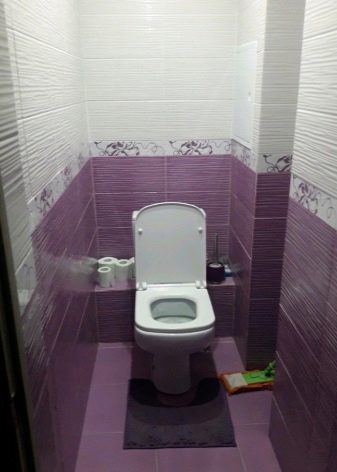
- The flooring can overlap with the back wall. Having decorated these areas with black tiles, the side walls can be made white according to the principle of contrast.
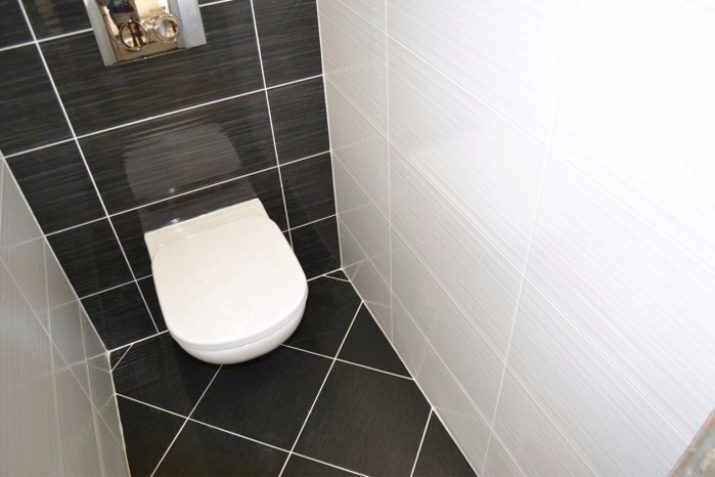
- If the tile is combined with the wallpaper in the toilet and is located in the lower half of the wall, then along its edge you can lay out elements with a pattern that will match in style and color with the upper part of the wall.

- The colorful back wall tiles will only make the washroom look catchy if these vibrant colors are diluted with neutral light side wall coverings.

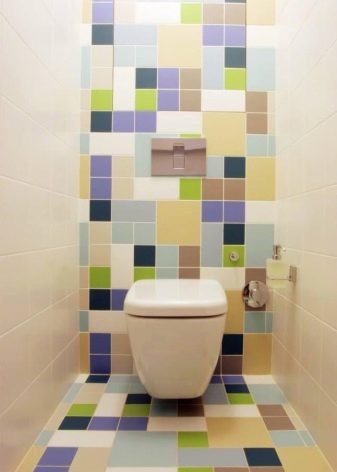
An overview of the stages of repairing a toilet with laying tiles, see below.








